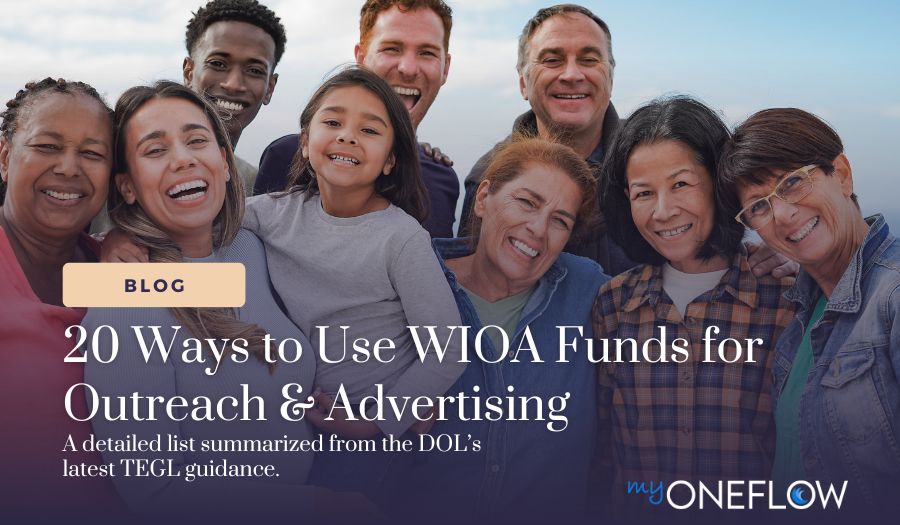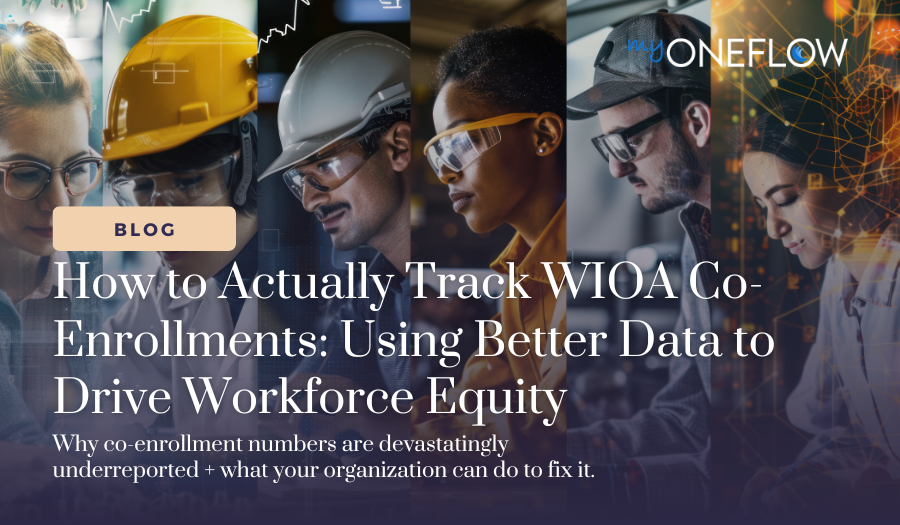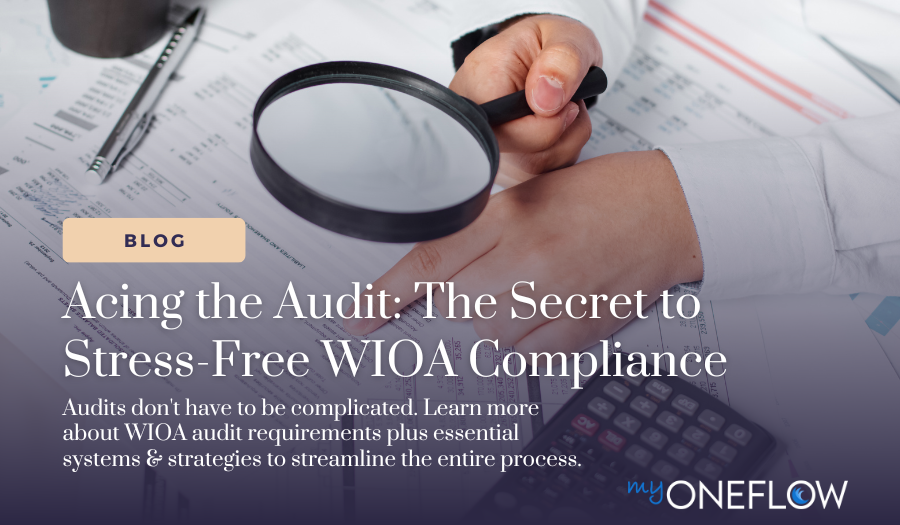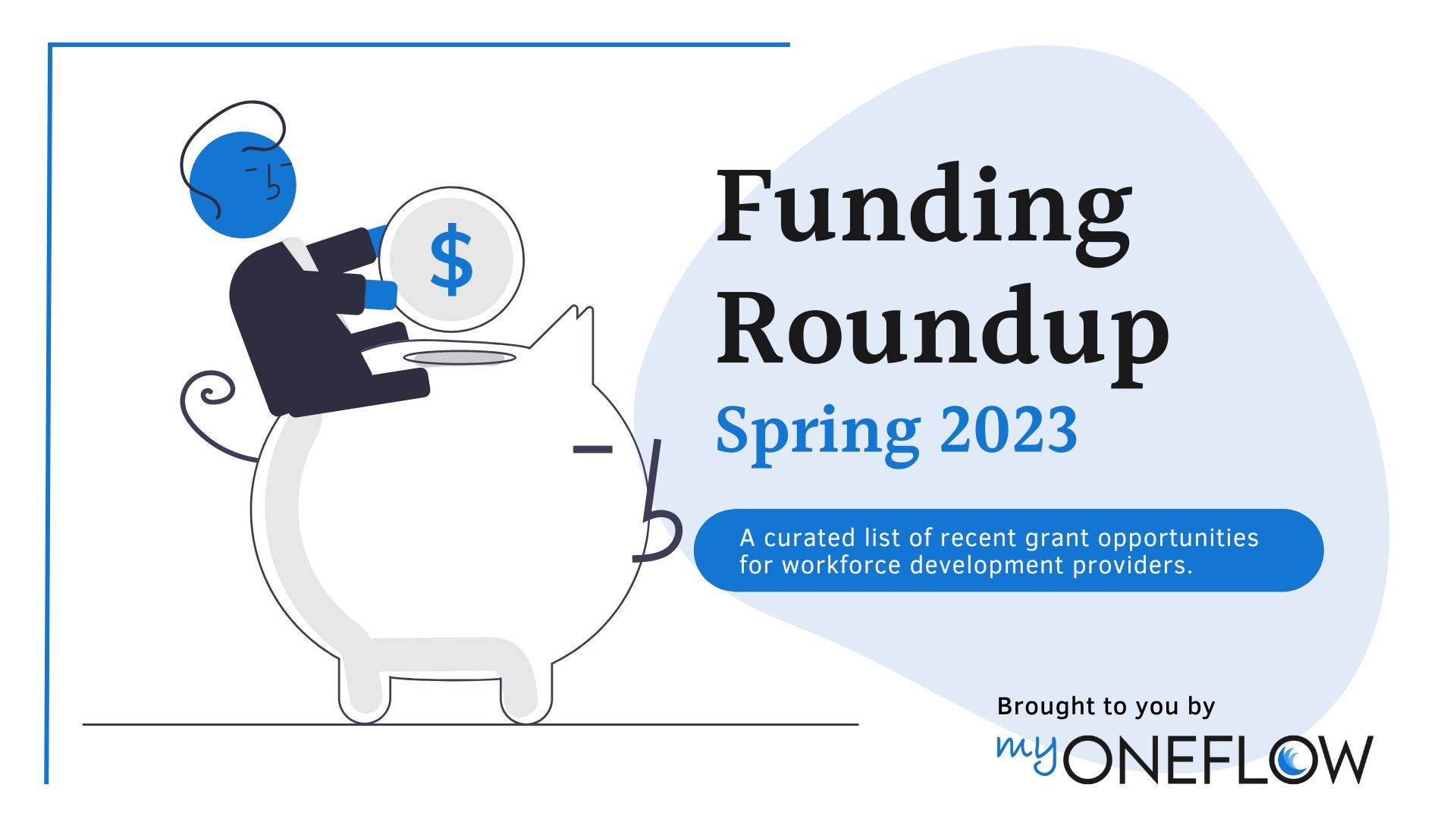How to Actually Track WIOA Co-Enrollments: Using Better Data to Drive Workforce Equity
The Workforce Innovation and Opportunity Act (WIOA) is rooted in a bold ambition: “to strengthen the United States workforce development system...
5 min read
myOneFlow Staff Sep 27, 2023 12:39:31 PM

The U.S. Department of Labor recently released a new Training and Employment Guidance Letter (TEGL), TEGL 03:23, to provide workforce agencies and other DOL grantees with clear instructions on how to use funds from the Workforce Innovation and Opportunity Act (WIOA) and other competitive grants effectively and equitably for outreach activities. WIOA is crucial in connecting job seekers with employers, providing training opportunities, and helping businesses recruit skilled employees.
For workforce boards and other DOL grantees, this new TEGL guidance provides your organization with a roadmap for using WIOA and other competitive grant funds for outreach activities. Targeted outreach and advertising can help you increase engagement with local businesses and job seekers and expand the reach of your services, particularly to those in underrepresented communities. In this article, we'll 20 ways you can use WIOA funds to maximize your organization's reach, better serve local businesses and job seekers, and contribute more significantly to developing your local workforce.
TEGL 03:23 outlines specific allowable ways to use WIOA funding for targeted outreach that may help you generate ideas for your organization. Please note that this is not an exhaustive list.
1. Community Events: Organizations can attend local fairs, industry events, or other community gatherings with materials about job assistance, resume development, career advice, and interview skills. They can also set up a recruitment display table to distribute information about grant-related services. Locations such as libraries, religious institutions, laundromats, grocery stores, and local businesses are ideal for meeting potential participants. These places often allow organizations to join existing events or use their location as a venue for outreach and enrollment events.
2. Partnering with Local Businesses: Organizations can reach out to local businesses like barber shops, hair salons, movie theaters, sporting events, and restaurants to post and share their posters or signs. Local businesses may also allow grantees to join their planned events or use their location for outreach and enrollment events.
3. Engaging Community Leaders: Community leaders and partners can help spread the word about the services provided by the grantee. It's important to ensure they have enough information about the services to refer individuals to the appropriate organizations.
4. Participation in Job/Career Fairs: Other in-person activities for outreach could include attendance at, facilitation of, collaboration with, or participation in job/career fairs, rapid response events, one-stop satellite centers/mobile one-stops, high school/college career days, and other interviews.
5. Promotional Materials: Creating promotional materials such as brochures, pamphlets, or flash drives to distribute at public relations events is an allowable use of funds. These materials can educate the public about the award’s activities, services, and program offerings.
6. Mobile American Job Centers (AJCs): Organizations can use WIOA funds to establish and run mobile American Job Centers (AJCs). These mobile units can be used to reach out and provide services to people throughout the community, especially in rural areas. Funds can be used for vehicle purchase, repair, and maintenance, following the guidelines in 2 CFR 200.403 and 2 CFR 200.405(d). If the vehicle benefits multiple programs, costs should be allocated based on each program's relative benefit.
Each of these methods can be tailored to reach special or targeted populations, and organizations may need unique strategies for locating, attracting, and retaining different segments of participants for their programs.
7. Newspaper and Newsletter Ads: Organizations can create advertisements or write articles that can be published in local newspapers or neighborhood newsletters.
8. Informational Postcards, Brochures, and Flyers: These are traditional yet effective tools for distributing information about grant-funded activities, services, or programs.
9. Doorknob Hangers, Pamphlets, and Leaflets: These materials can be distributed in neighborhoods or at community events, providing a tangible reminder of the available services.
10. Public Signage: Funds can be used for larger-scale advertising, such as bus stop signage, benches, banners, billboards, or vehicle wraps. This can increase visibility in the community.
11. QR Codes: These can be included on any printed material to direct potential participants to online information about the grant-funded activities, services, or programs.
12. Community Service Groups: Organizations can use funds to send notices about openings in their programs and activities to schools and community service groups.
The Employment and Training Administration (ETA) interprets printed outreach materials as efforts to educate, enroll, employ, or extend referrals to customers potentially interested in ETA’s publicly funded workforce development efforts. This broad interpretation gives organizations a great deal of flexibility in using WIOA funds for print advertising.
13. Advertising Grant Services: Local radio and TV stations can be cost-effective platforms to advertise the services provided by the grant. These mediums reach a wide audience and can significantly boost awareness.
14. Researching and Reaching Out to Media Personalities: Organizations can research and connect with media personalities who cover topics related to their grant award. This could lead to potential partnerships or features that further promote their services.
15. Engaging with Specific Reporters: If a specific radio or TV station reporter covers a particular neighborhood or local community, organizations can reach out to them for potential coverage or collaboration.
16. Interviews: Organizations can use WIOA funds to promote their federally-funded activities, services, or programs through blog and podcast interviews. These platforms provide interactive content targeted at specific audiences. However, factors such as frequency of use, potential participant costs (like subscription services for some podcasts), and availability of ongoing content should be considered when using this form of outreach.
17. Email Communication: Emails are an effective medium for disseminating information to participants and potential partners. Email signature lines can be used to promote websites, QR codes, or upcoming events related to the organization's activities, services, or programs.
18. Text Messaging Applications: WIOA funds can also be used to maintain communication with program participants through text messaging applications. This method is beneficial for real-time communication, such as reminders of appointments, promotion of new programs/services, or sharing employment opportunities. Some text messaging tools offer automation features and analytics, which can help organizations adapt their outreach strategies.
19. Social Media: WIOA funds can be used to create social media accounts on platforms like Instagram, Facebook, LinkedIn, etc., to promote grant services, raise program awareness, and strengthen community ties. Activities could include following local community-based organizations, engaging with their content, and sharing multimedia posts related to the organization's work. However, grantees need to ensure they comply with federal or state laws and grant award terms that may prohibit the use of certain platforms or activities.
20. Influencers: Organizations can also leverage influencers with large followings on media platforms to promote their programs and services. Organizations should provide detailed information about the federal award’s activities, services, and programs when contracting with influencers. Factors such as the influencer's reputation, follower base, potential participant receptivity, technology access of participants, and cost/benefit comparison to traditional outreach methods should be considered.
Remember, all these strategies should be carried out while adhering to the Uniform Guidance’s Cost Principles and ensuring compliance with state or local vetting requirements. It's also crucial to ensure participant data privacy in all communication activities. Organizations should review the data privacy policies of text messaging applications and other social media platforms.
WIOA reporting is complex, and organizations need modern technology to effectively utilize grant funding while remaining compliant. myOneFlow is a comprehensive, end-to-end grant management & case management solution designed to facilitate a transparent and efficient process for grantors, grantees, and participants. With a single, unified platform, myOneFlow securely engages all stakeholders, including applicants, staff, and collaborating partners. It leverages AI-powered workflows to maintain connectivity throughout the grant lifecycle, even at the subgrantee level. The platform simplifies every stage of the grant management process, from application to participant spending, with advanced custom reporting tools that ensure easy compliance and meet state/grantor reporting requirements. Contact our team of WIOA specialists to discuss how myOneFlow can support your organization and community needs.
myOneFlow is not affiliated with the Department of Labor or any other government entity, and the information in this article is summarized for informational purposes only. For final details from the ETA on this new guidance, organizations should refer to TEGL 03-23.

The Workforce Innovation and Opportunity Act (WIOA) is rooted in a bold ambition: “to strengthen the United States workforce development system...

If you're a workforce or adult ed program receiving WIOA funding, chances are you're audited annually. While the thought of audits might conjure...

Subscribe to the myOneFlow newsletter and join the WIOA Management Professionals LinkedIn group to get automatic updates about new funding...